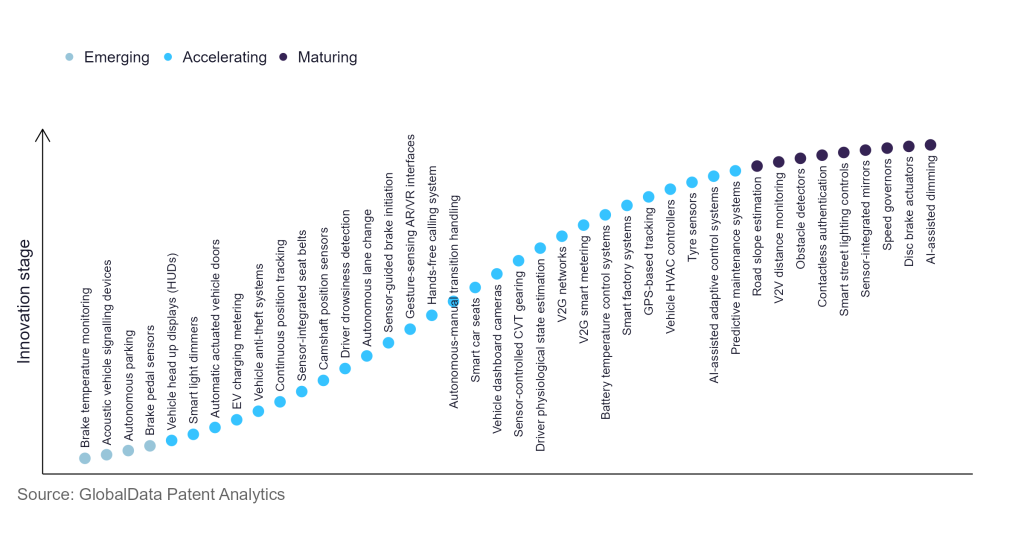The automotive industry continues to be a hotbed of innovation, with activity driven by advanced security features and autonomous vehicles, and growing importance of technologies such as speed sensors, hall-based sensors and tunnel magneto resistance (TMR) based sensors. In the last three years alone, there have been over 1.2 million patents filed and granted in the automotive industry, according to GlobalData’s report on Internet of Things in Automotive: Sensor-controlled CVT gearing. Buy the report here.
However, not all innovations are equal and nor do they follow a constant upward trend. Instead, their evolution takes the form of an S-shaped curve that reflects their typical lifecycle from early emergence to accelerating adoption, before finally stabilising and reaching maturity.
Identifying where a particular innovation is on this journey, especially those that are in the emerging and accelerating stages, is essential for understanding their current level of adoption and the likely future trajectory and impact they will have.
290+ innovations will shape the automotive industry
According to GlobalData’s Technology Foresights, which plots the S-curve for the automotive industry using innovation intensity models built on over 619,000 patents, there are 290+ innovation areas that will shape the future of the industry.
Within the emerging innovation stage, acoustic vehicle signalling devices, autonomous parking, and brake pedal sensors are disruptive technologies that are in the early stages of application and should be tracked closely. Vehicle head up displays (HUDs), smart light dimmers, and automatic actuated vehicle doors are some of the accelerating innovation areas, where adoption has been steadily increasing. Among maturing innovation areas are road slope estimation and V2V distance monitoring, which are now well established in the industry.
Innovation S-curve for IoT in the automotive industry

Sensor-controlled CVT gearing is a key innovation area in IoT
The sensor-controlled continuously variable transmission (CVT) gearing consists of seven smaller systems, including a vehicle’s mechanical, electrical, and oil systems, to provide fuel efficiency and continuous power. Current CVT systems use hall sensors or pressure sensors for various measurements. The CVT uses the readings of multiple sensors to keep the engine rotating at a precise rpm with two variable pulleys and a steel belt.
GlobalData’s analysis also uncovers the companies at the forefront of each innovation area and assesses the potential reach and impact of their patenting activity across different applications and geographies. According to GlobalData, there are 10+ companies, spanning technology vendors, established automotive companies, and up-and-coming start-ups engaged in the development and application of sensor-controlled CVT gearing.
Key players in sensor-controlled CVT gearing – a disruptive innovation in the automotive industry
‘Application diversity’ measures the number of different applications identified for each relevant patent and broadly splits companies into either ‘niche’ or ‘diversified’ innovators.
‘Geographic reach’ refers to the number of different countries each relevant patent is registered in and reflects the breadth of geographic application intended, ranging from ‘global’ to ‘local’.
Patent volumes related to sensor-controlled CVT gearing
| Company | Total patents (2021 - 2023) | Premium intelligence on the world's largest companies |
| Nissan Motor | 519 | Unlock Company Profile |
| Kubota | 92 | Unlock Company Profile |
| Zeppelin-Stiftung | 66 | Unlock Company Profile |
| Yanmar Holdings | 45 | Unlock Company Profile |
| AGCO | 40 | Unlock Company Profile |
| Robert Bosch Stiftung | 28 | Unlock Company Profile |
| AB Volvo | 19 | Unlock Company Profile |
| Caterpillar | 12 | Unlock Company Profile |
| Dana | 11 | Unlock Company Profile |
| Toyota Motor | 10 | Unlock Company Profile |
| Komatsu | 10 | Unlock Company Profile |
| YANMAR POWER TECHNOLOGY | 6 | Unlock Company Profile |
| ZF Industrientriebe Witten | 5 | Unlock Company Profile |
Source: GlobalData Patent Analytics
Nissan is a key player in the sensor controlled CVT gearing innovation area with 519 patents filed. The company’s sensor controlled CVT gearing uses sensors from the combination meter, the gear shifter and under the hood on both sides of the vehicle. It includes a control unit that changes the gear ratio in response to signals from sensors that monitor vehicle speed, engine load, and driving conditions. Kubota, Yanmar and Zeppelin-Stiftung are the other key players.
To further understand how IoT is disrupting the automotive industry, access GlobalData’s latest thematic research report on Internet of Things (IoT) in Automotive.
Data Insights
From

The gold standard of business intelligence.
Blending expert knowledge with cutting-edge technology, GlobalData’s unrivalled proprietary data will enable you to decode what’s happening in your market. You can make better informed decisions and gain a future-proof advantage over your competitors.







